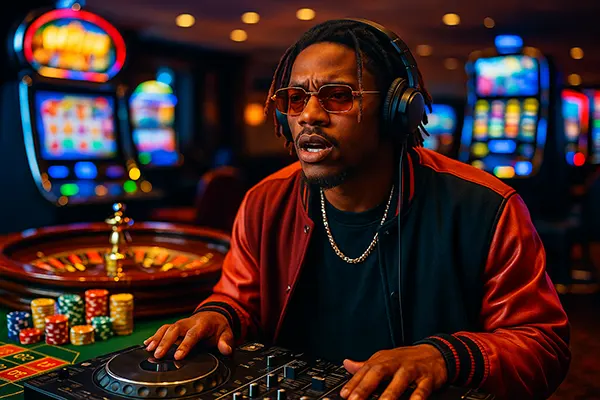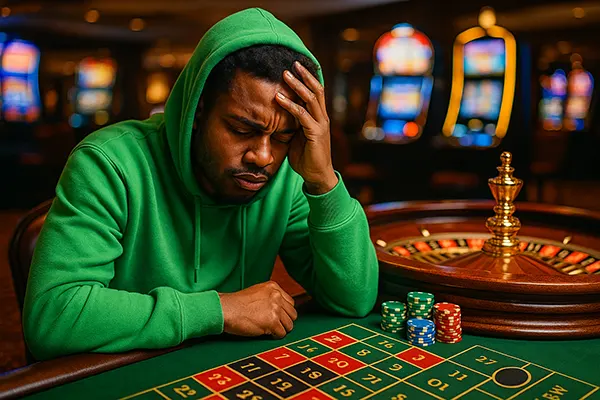Casino Aesthetics in Hip-Hop: How Gambling Samples Shape Gen Z Culture

Hip-hop has always been a reflection of cultural evolution, societal trends, and technological influence. In recent years, a unique trend has emerged that blends the sonic identity of gambling with the world of rap, trap, and drill. From the clatter of slot reels to the shuffle of cards and the jingle of casino chips, gambling samples are increasingly embedded in the beats of top artists. This fusion is not coincidental—it mirrors a generation raised on digital interactivity, visual luxury, and high-risk aspirations.
From Reels to Rhymes: The Sonic Crossover
One of the most prominent ways casinos have entered the music scene is through sampling. Beatmakers incorporate the auditory cues of slot machines, roulette spins, and card shuffles directly into instrumental layers. These sounds, once confined to casino halls, now underscore verses about success, risk, and escape. For example, Travis Scott has flirted with slot-style samples in unreleased snippets, creating an aura of unpredictability and stakes.
Metro Boomin, known for his atmospheric and cinematic production, occasionally inserts sounds resembling casino ambiances to evoke tension or luxury. Such elements help establish a sonic metaphor for gambling not only with money but with life itself. These samples work as both background texture and narrative enhancer, reflecting themes of chance, hustle, and payoff that dominate trap culture.
Even mainstream stars like Doja Cat and Kanye West have nodded toward gambling aesthetics. While not always literal, their tracks often rely on rhythmic structures and melodic loops that echo the tension-release pattern of games like blackjack or roulette. The implication is clear: risk and reward are part of the modern artist’s story.
The Role of Audio Symbolism in Hip-Hop Identity
Incorporating casino sounds is more than just a trend—it’s symbolic. For many artists, these samples reflect their real-life ascent from uncertainty to fame, echoing the unpredictability of a roulette wheel. The listener is not only entertained but drawn into the psychological highs and lows of the artist’s experience.
Casino samples carry connotations of power, danger, and reward—factors that align closely with street credibility in hip-hop. This auditory branding signals wealth and survival against odds, turning every spin or chip sound into an emotional narrative. The artist doesn’t just rap about making it—they let the listener feel the gamble through sonic cues.
This auditory branding also builds bridges with Gen Z, who are accustomed to digital sensory overload. For this audience, casino sounds evoke games, apps, and the thrill of unpredictability—turning each track into a miniature story of triumph and chance.
Gambling as a Cultural Mirror for Gen Z
The rise of gambling references in music reflects deeper trends in Gen Z culture. This generation grew up on loot boxes, gacha mechanics, and influencer giveaways—all systems based on randomness. Their worldview often equates success with lucky breaks, viral fame, or high-risk plays. Casino samples in hip-hop music naturally align with this psychological framework.
Gambling also appeals to Gen Z’s visual culture. Neon lights, luxury tables, and spinning reels are aesthetic staples in Instagram feeds and TikTok edits. By aligning their sound with this aesthetic, artists become part of a broader visual and emotional language that resonates with youth culture.
Moreover, Gen Z embraces hybridity and irony. They know the risks of gambling but also romanticise its glamour. Hip-hop tracks that weave casino audio into their beats are tapping into this duality—both criticising and celebrating the gamble of modern life. For Gen Z, this tension is relatable and real.
The Allure of Risk as a Lifestyle Statement
For many young listeners, gambling doesn’t represent vice—it represents possibility. The act of taking risks is framed not as recklessness but as strategy, a way to break out of societal expectations. Casino sounds in hip-hop evoke this mindset, positioning risk as empowerment.
Artists who use these samples effectively speak to a broader cultural longing for control in an unstable world. Whether it’s escaping poverty or achieving digital fame, the underlying message is about creating one’s own odds. Gambling motifs offer a way to sonically express this agency.
Additionally, the aesthetic of casinos complements the aspirational nature of rap. Expensive suits, diamond-encrusted watches, private tables—these aren’t just fantasies; they’re status signals. The audio of chips and wheels reinforces that message without a single word.

Sample Packs and the Beatmaker Renaissance
Behind the scenes, beatmakers and producers are curating extensive sample packs featuring gambling-related sounds. These include slot effects, coin drops, roulette spins, dealer phrases, and more. Accessible through marketplaces like Splice, these packs empower up-and-coming producers to experiment with themes of chance and tension in their compositions.
For example, 2025 has seen a rise in niche kits titled “Casino Night,” “Lucky Loops,” or “Jackpot Drums.” These tools aren’t just for novelty—they’re crafted to provide serious atmospheric tools for storytelling. Producers use them to inject unpredictability into drops or to build transitions that mimic the flow of a high-stakes game.
Sampling casino sounds gives underground artists a way to compete with the narrative richness of mainstream acts. It’s a low-cost but high-impact method of embedding cultural critique or commentary into instrumental tracks. Gambling, in this sense, becomes not just a theme—but a toolkit.
Innovation and Sound Engineering in 2025
Sound design has evolved to the point where gambling samples can be fully re-engineered into rhythmic instruments. Instead of using them as background effects, producers now manipulate pitch, delay, and tempo to turn these noises into central melodic elements.
This innovation has created a hybrid genre space where audio minimalism meets storytelling. Casino pings, once static, are now stretched into synth lines or layered into percussive patterns. This creative freedom expands the boundaries of trap, drill, and alternative hip-hop in profound ways.
Ultimately, the use of gambling samples is no longer niche—it’s part of the mainstream producer’s arsenal. As sound libraries grow, the line between beat and metaphor continues to blur, offering new possibilities for artistic self-expression in the world of urban music.
